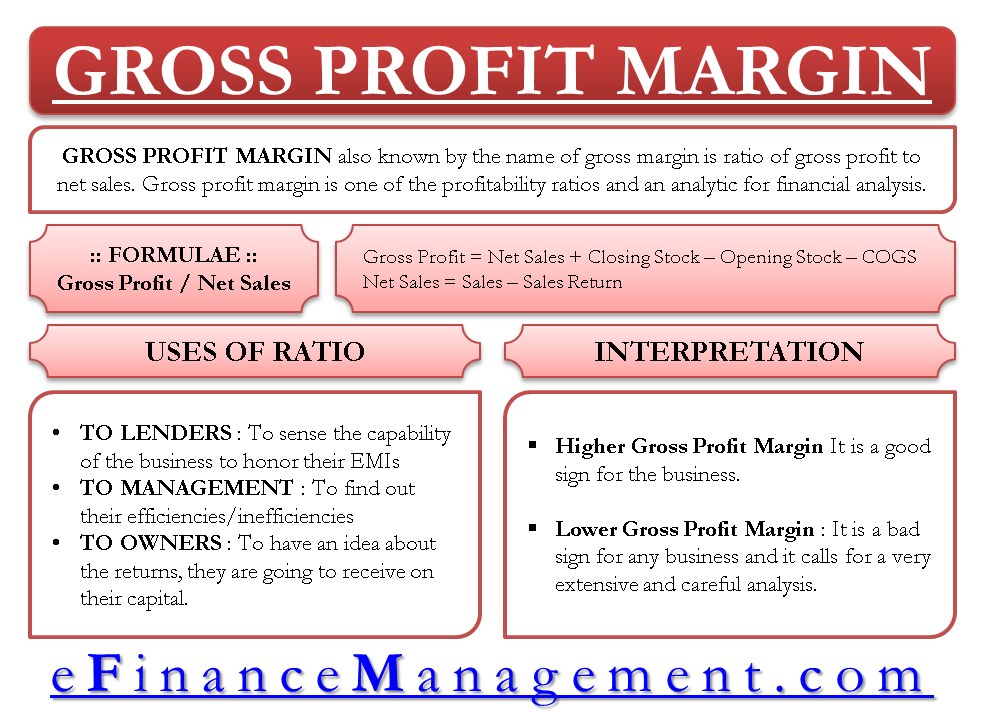What is Gross Margin or Gross Profit Margin?
Gross profit margin (GP Margin) is the ratio of gross profit to net sales. The other names for GP margin are gross profit ratio or gross margin. It is a significant ratio as it deals with profit which is the final goal of all the strategies and decisions in a business. GP margin is the first benchmark for business. There is no point in looking at anything else without doing well at this benchmark.
Gross profit margin is one of the profitability ratios and an analytic for financial analysis. This ratio speaks about the adequacy of the profits per dollar of sales and the growth/decline in performance compared to the previous period or the industry. Adequacy of profit is defined as covering the operating expenses and an acceptable return to the shareholders.
Operating expenses may include selling and distribution expenses, administration, financing charges, taxes, etc.
GP margin is the margin of profit that remains after deducting manufacturing or trading expenses from the net sales. It is a significant ratio because it evaluates both the efficiency and pricing policy of a business. This ratio always hints at essential business factors, whether the ratio is low or high compared to the past or in comparison with the industry.

Calculation of Gross Profit Ratio
The calculation is as follows::
Gross Profit Margin Formula
The formula for GP margin is very simple, and it is as under:
| Gross Profit Margin/Ratios = Gross Profit / Net Sales |
Where GP = Net Sales + Closing Stock – Opening Stock – Cost of Goods Sold
And, Net Sales = Sales – Sales Return

The calculation for GP margin is straightforward, but some components are derived from the management’s discretion, mainly the opening and closing stocks. Management decides the base for the valuation of the stock. Here, there is a chance of manipulation. To show a higher GP margin, the management may overvalue the closing stock and undervalue the opening stock. This thing needs to be taken care of before calculating the gross margin.
Also Read: How to Analyze Gross Profit Margin?
Refer to GROSS PROFIT PERCENTAGE to learn more.
Uses of Gross Profit Margin
The GP margin is an important ratio that most business stakeholders use.
Lenders
The lenders use it to sense the capability of the business to honor their EMIs on time.
Management
The management looks at the gross margin to find their efficiencies and inefficiencies. Moreover, they improve the inefficient areas and capitalize on the efficient ones.
Owners
The owners look for it to have an idea about the returns they will receive on their capital.
Interpretation of Gross Profit Ratios
The gross profit margin, say 30%, states that 30% of net sales are available to pay off all the operating expenses, including selling and distribution, administration, financing, and taxes. The gross profit should be at least equal to all the operating expenses for a business to continue. Otherwise, there would be a net loss, and a loss-making business model cannot survive long in the market.
Management aims to achieve a gross profit margin as high as possible. If the margin is high, the management is considered to be good and effective. Therefore, the management focuses on how to increase gross margin. However, in both situations, high or low GP margin calls for research and analysis of the ratio. Finding the reasons behind the nature of the ratio is significant to know if the management is actually efficient or if there are some other reasons.
Higher Gross Profit Margin
The higher GP margin may be a reason for efficient management, low cost of production, an increase in the sales price, or over or undervaluation of stock. All other reasons are valid except the stock valuation as that does not show efficiency in running the business.
To learn more, refer to Reasons for Higher Gross Profit Margin.
Lower Gross Profit Margin
A lower GP margin is a bad sign for any business, and it calls for a very extensive and careful analysis. The reason for a lower gross margin can be a higher cost of production, a decline in the sales price, or if there is a change in the sales mix. All these factors need to have an in-depth analysis and watch throughout the year to avoid a situation of lower gross margins.
To learn more, refer to Reasons for Lower Gross Profit Margin.
Read more on CONTRIBUTION MARGIN vs. GROSS MARGIN.

